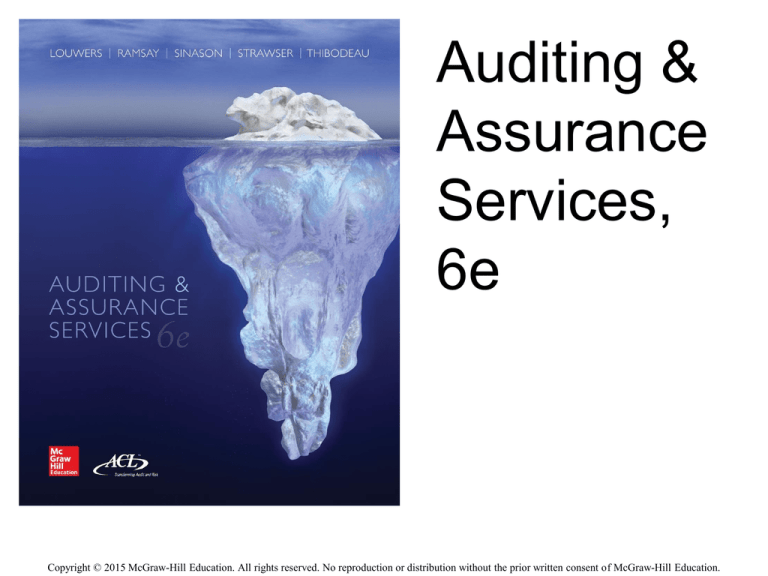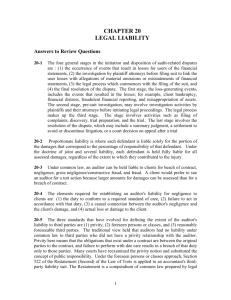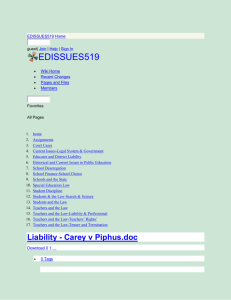
Auditing &
Assurance
Services,
6e
Copyright © 2015 McGraw-Hill Education. All rights reserved. No reproduction or distribution without the prior written consent of McGraw-Hill Education.
Module C
Legal Liability
“When men are pure, laws are useless; when men are corrupt,
laws are broken.”
Benjamin Disreali, Former British Prime Minister
Mod C-2
Module Objectives
1.
2.
3.
4.
5.
6.
Identify and describe auditors’ exposure to lawsuits and
loss judgments.
Specify the characteristics of auditors’ liability under
common law and cite some specific case precedents.
Identify auditors’ liability to third parties under
statutory law.
Specify the civil and criminal liability provisions of the
Securities Act of 1933.
Specify the civil and criminal liability provisions of the
Securities Exchange Act of 1934.
Understand recent developments that affect auditors’
liability to clients and third parties.
Mod C-3
The Legal Environment
Auditors
Issue auditors’ report
Performs services in accordance with
contract
Conduct a GAAS audit
Third-party
user of F/S
Client
Rely on audited F/S in making
economic decisions
Mod C-4
Sources of Auditor Liability
• Common law: Uses legal precedent to
identify responsibility.
– Clients
– Nonshareholder third parties
• Statutory liability: Based on violations of
written statutes.
– Shareholders
Mod C-5
Major Topics
I. Common Law Liability
– Clients
– Third Parties
II. Statutory Liability
– Securities Act of 1933
– Securities Exchange Act of 1934
III. Developments in Auditor Liability
Mod C-6
Common Law
• Breach of contract: Services not performed by
auditors in manner described in contract
• Tort liability: Obligation based on failure of
auditors to exercise appropriate level of
professional care
– Ordinary negligence is lack of reasonable care
– Gross negligence is lack of minimal care (similar to
constructive fraud)
– Fraud is a misrepresentation of fact an individual knows
to be false
Mod C-7
Common Law Liability: Clients
• Breach of contract
– Contractual relationship with client (through
engagement letter) creates potential liability
• Tort liability
– Liable for ordinary negligence, gross
negligence, and fraud
Mod C-8
Proof and Defenses: Clients
• Clients must show
– Economic loss
– Auditors breached contract or failed to exercise appropriate
care
– The loss was caused by the breach of contract or failure of
auditors to exercise the appropriate level of care
• Defenses
– Auditors did not breach contract or performed with
appropriate level of care
– Causation (something else caused client loss)
– Contributory negligence (clients were partially responsible
for loss)
Mod C-9
Major Topics
I. Common Law Liability
– Clients
– Third Parties
II. Statutory Liability
– Securities Act of 1933
– Securities Exchange Act of 1934
III. Developments in Auditor Liability
Mod C-10
Types of Third Parties
• Primary beneficiaries: Known by
name to the auditor
• Foreseen: Parties who could
reasonably be expected to rely
on the auditors’ work
• Foreseeable: Parties whose
decisions normally rely on
audited F/S and opinions on
those F/S
More
Known
to
Auditor
Less
Known
to
Auditor
Mod C-11
Common Law Liability: Third
Parties
• Generally liable to all third parties for gross
negligence and fraud
• Liability for ordinary negligence
– Ultramares: No liability for ordinary negligence
– Credit Alliance v. Arthur Andersen: Liable to primary
beneficiaries for ordinary negligence
– Fleet National Bank (restatement of torts): Liable to
foreseen third parties for ordinary negligence
– Rosenblum v. Adler: Liable to foreseeable third parties
for ordinary negligence
Mod C-12
Proof and Defenses: Third Parties
• Third parties must show
–
–
–
–
Economic loss
Auditors failed to exercise appropriate level of care
F/S contained a material misstatement
Loss caused by reliance on misstated F/S
• Defenses
– Lack of appropriate standing (relationship with auditor) to
bring suit
– Third party’s loss caused by factors other than the F/S and
auditors examination (causation defense)
– Audit conducted per GAAS
Mod C-13
Summary of Liability for
Ordinary Negligence
Ultramares: Liable for GN and F
Credit Alliance v. Arthur
Andersen:
ON to primary
beneficiaries
Fleet National Bank v.
Gloucester Co:
ON to foreseen
(restatement of torts)
Less Exposure
Rosenblum v. Adler:
ON to foreseeable
More Exposure
Mod C-14
Summary of Common Law Liability
• Liability to clients
– Breach of contract
– Tort liability for ON, GN, F
• Liability to third parties
– Only tort liability, unless they contract with
auditors
– Liable to all for GN and F
– Liability for ON depends upon relationship and
jurisdiction
Mod C-15
Major Topics
I. Common Law Liability
– Clients
– Third Parties
II. Statutory Liability
– Securities Act of 1933
– Securities Exchange Act of 1934
III. Developments in Auditor Liability
Mod C-16
Statutory Liability
• Violations of specific laws or statutes
• Securities Acts
– Regulate securities trading in the U.S.
– Require disclosure of important financial and nonfinancial
information using GAAP
– Require audited F/S
Mod C-17
Securities Act of 1933
(Securities Act)
• Regulates initial issuance of securities by
registrants to investing public
• Required to file registration statement
with SEC that includes F/S
• To bring suit, investors must show:
– Loss
– F/S contained a material misstatement
– No need to show reliance on F/S or that loss
was caused by misstatement
Mod C-18
Liability Under Securities Act
• Auditors responsible for ordinary negligence,
gross negligence, and fraud
• Defenses
– Due diligence (auditors performed a GAAS audit)
– Causation (loss resulted from other factors)
• Escott v. BarChris Construction Corp.
– Auditors held liable for failure to conduct
“reasonable investigation” (ordinary negligence)
Mod C-19
Civil and Criminal Liability
• Civil Liability (Section 11)
– Because auditors are “experts” and must perform
a “reasonable investigation”, they have liability
under Section 11
– Burden of proof has shifted to the auditors
• Criminal Liability (Section 24)
– Auditors must have “willfully” violated provisions
of the Securities Act (fraud or GN)
– United States vs. Benjamin addressed criminal
liability
Mod C-20
Major Topics
I. Common Law Liability
– Clients
– Third Parties
II. Statutory Liability
– Securities Act of 1933
– Securities Exchange Act of 1934
III. Developments in Auditor Liability
Mod C-21
Securities Exchange Act of 1934
(Securities Exchange Act)
• Regulates daily trading of securities and requires
periodic financial statements and information to
be filed with the SEC
• Reports filed with SEC
– Form 10-K: Annual F/S (audited)
– Form 10-Q: Quarterly F/S (reviewed)
– Form 8-K: “Current events” report filed as appropriate
Mod C-22
Liability under the
Securities Exchange Act of 1934
• To bring suit, investors must show:
– Economic loss
– F/S contained a material misstatement
– Loss caused by reliance on F/S (burden of proof shifted to
investor)
– Auditors were aware that the F/S contained a material
misstatement (has been interpreted as gross negligence)
Mod C-23
Liability under the
Securities Exchange Act of 1934
• Auditors liable for gross negligence and fraud
– Scienter is a mental state embracing the intent to
deceive, manipulate, or defraud
• Defenses
– Auditors acted in good faith
– Auditors were not aware of material misstatements
• Ernst & Ernst v. Hochfelder
– Relieved auditors from liability for ordinary negligence
– Did provide liability for “reckless behavior” in the
absence of scienter
Mod C-24
Civil and Criminal Liability
• Civil Liability (Rule 10b-5 and Section 18)
– Plaintiffs have burden of proof
– Auditors cannot be held liable for ON
• Criminal Liability (Section 32)
– Did auditors act “willfully and knowingly”?
– Fines of up to $5 million and imprisonment for up
to 20 years
– United States vs. Natelli (“National Student
Marketing”)
Mod C-25
Summary of Auditor Liability
Source
Burden of
Proof
Offense
Auditors’ Defenses
Common Law/Clients
Client
Breach of contract
ON, GN, F
• No breach or inappropriate
performance (GAAS audit)
• Causation
• Contributory negligence
Common Law/Third
Parties
Third Parties
ON depends upon
party and
jurisdiction
• Lack of appropriate third party
standing
• Causation
• No inappropriate performance
(GAAS audit)
GN, F
Securities Act of 1933
Auditors
ON, GN, F
• Due diligence (GAAS audit)
• Causation
Securities Act of 1934
Investors
GN, F
• Good faith
• No knowledge of material
misstatements (“scienter”)
ON = Ordinary negligence
GN = Gross negligence
F = Fraud
Mod C-26
Major Topics
I. Common Law Liability
– Clients
– Third Parties
II. Statutory Liability
– Securities Act of 1933
– Securities Exchange Act of 1934
III. Developments in Auditor Liability
Mod C-27
Why Has Auditor Liability
Increased?
• Highly-publicized failures (WorldCom, Enron)
• Investor awareness of ability to recover
monetary losses from auditors
• Complex accounting standards
• Joint and several liability
• Class action suits
• Auditors (“deep pockets”) are an attractive
target for plaintiff attorneys
Mod C-28
Sarbanes-Oxley
• Extends statute of limitations for brining suit
under the Securities Exchange Act
• Increased penalties for mail fraud and wire fraud
• Increased penalties for destruction, alteration,
and falsification of records
• Increased records retention requirements
• Higher potential liability in civil cases
Mod C-29
Other Developments in Auditor
Liability
• Auditors not subject to RICO (and treble
damages)
• Limitations on aiding and abetting
• Organization of firms as limited liability
partnerships
• Private Securities Litigation Reform Act
(1995)
– Proportionate liability, instead of joint and
several liability
Mod C-30
Other Developments in Auditor
Liability
• Class Action Fairness Act (2005)
– Moves class action cases from state courts to
federal courts
• Securities Litigation Uniform Standards Act
(1998)
– Requires class action lawsuits with > 50 parties
to be filed in federal courts
• Auditor liability caps
Mod C-31







